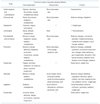Abstract
The prognosis of epilepsy has improved considerably, and about 80% of patients can now be expected to achieve a complete seizure control with antiepileptic drug treatment. It is important to understand that the response to individual drugs may vary considerably in relation to the seizure type or epilepsy syndrome, so that optimization of treatment requires careful individualization of the dosage, and that rational polytherapy should be performed in consideration of the mechanisms of action of antiepileptic drugs, adverse effects, and drug interactions. Although newly developed antiepileptic drugs have some advantages in terms of adverse effects and pharmacokinetics compared with traditional antiepileptic drugs, they have demonstrated no significant difference in efficacy in comparative studies. The purpose of this chapter is to review the basic principles, which should guide the optimal treatment with antiepileptic drugs in patients with epilepsy.
References
1. Deckers CL, Genton P, Sills GJ, Schmidt D. Current limitations of antiepileptic drug therapy: a conference review. Epilepsy Res. 2003. 53:1–17.

2. Marson AG, Kadir ZA, Hutton JL, Chadwick DW. The new antiepileptic drugs: a systemic review of their efficacy and tolerability. Epilepsia. 1997. 38:859–880.





 PDF
PDF ePub
ePub Citation
Citation Print
Print






 XML Download
XML Download